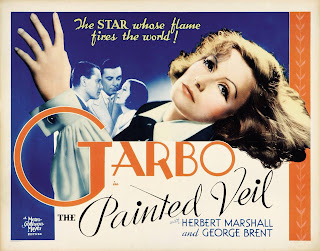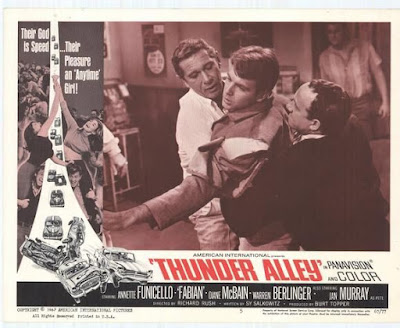The cold, dark, rainy month of March provided an ideal environment to relax in the movie room and indulge in cinematic fantasy. I focused on three very dissimilar show business legends: Greta Garbo, Humphrey Bogart and Elvis Presley. The fact that these three legendary figures have absolutely no connection to each other shows how "all over the place" my interest in films has become. I sometimes wish I could be fanatically devoted to only one genre, like horror, for example. That would save me a lot of money, not to mention shelf space. I have the complete collection of Elvis' theatrical features, and most of his concert films as well. This is a little bit strange, considering that during my teenage years in the 1960's I saw only a few of his movies when they played in theaters. To be honest, I started collecting his films because they were so cheaply priced in the catalogs I received every month from Oldies.com. Most of them sat on the shelves unopened for quite a long time before I was curious enough to watch them. I always liked Elvis Presley, but I've never been a diehard fan. His early films were his best, not just for the quality of the music, but because they gave him a chance to do some serious acting. Elvis had a lot of potential as an actor. But it would seem that his manager, the infamous Col. Tom Parker, had other plans. After G.I. BLUES and BLUE HAWAII came out and made tons of cash, most of Elvis' films fell into a pattern of general mediocrity for the remainder of the decade. I decided to watch a few of his movies after all these years. HARUM SCARUM (1965), KISSIN'COUSINS (1964), FUN IN ACAPULCO (1963), and GIRLS! GIRLS! GIRLS! (1962) were all first watches. Each one was as somniferous as the one before it. I was almost relieved to have found a cure for my chronic insomnia. SPEEDWAY (1968) was one of the Elvis flicks I saw at the show, and I remembered liking it. Watching it again after all this time was less than exciting. The two best things about it were the hit song "Let Yourself Go", which I had owned as a 45 RPM single back in 1968, and the refreshing presence of Nancy Sinatra, one of Elvis' more interesting leading ladies.

The one pleasant surprise in my Presley experience was the 1962 release KID GALAHAD, with Elvis playing a prize fighter. A very loose remake of the 1937 classic starring Edward G. Robinson and Bette Davis, this gave Elvis one of his last opportunities to do some serious acting, and he does a good job. And he's supported by a decent cast of actors: Lola Albright, Gig Young, Joan Blackman, and Charles Bronson. There are still too many totally forgettable songs, but the film makes a good dramatic point. It's light years away from something like KISSIN' COUSINS.
.jpg)
My interest in the Divine Garbo had intensified after reading the wonderful biography by Robert Gottlieb. (See my review posted 3/31/22.) After getting deep into the book, I sent away for several of Garbo's films, most of which I'd never seen. A Garbo marathon that began in February continued in March, beginning with the star's sound debut in ANNA CHRISTIE (1930), which I had seen before. This was followed by her silent classics: JOYLESS STREET (1925), and TORRENT (1926), her American debut.
 |
| Garbo in her MGM film debut, TORRENT. |
Other Garbo films that I watched this month: SUSAN LENOX: HER FALL AND RISE (1931), in which she worked with Clark Gable, the man who would soon be known as the King of MGM, ROMANCE (1930), THE PAINTED VEIL (1934), and her final film, TWO-FACED WOMAN (1941). The latter film has taken a lot of criticism over the years as the movie that ended Garbo's career. But after this re-watch, I found myself appreciating it more than I had previously.
 |
| Greta Garbo and Clark Gable in SUSAN LENOX: HER FALL AND RISE in 1931. |


Humphrey Bogart has become one of my favorite actors in the last few years. As I've had the chance to see more of his films, I've come to realize how versatile he was, and how totally unique he was, and still is to this day. I've had a copy of THE CAINE MUTINY (1954) sitting on the shelves for quite a while, and decided to finally watch it. He gives an incredible performance, as do his co-stars Fred McMurray, Jose Ferrer, Van Johnson, and Robert Francis. I decided to send away for more of his films from Oldies.com. Some of them arrived this month, and I'm waiting for several others. One item I purchased was the SILVER SCREEN ICONS box set containing four of his best films: THEY DRIVE BY NIGHT (1940), ACROSS THE PACIFIC (1942), ACTION IN THE NORTH ATLANTIC (1943), and PASSAGE TO MARSIELLES (1944), all first watches and thoroughly enjoyable. I also picked up a Bogart title I'd never heard of, YOU CAN'T GET AWAY WITH MURDER (1939), in which he plays one of his most evil gangster characters, and plays it to the hilt.

.jpg)
While I was having a great time being immersed in Hollywood's Golden Age, I suddenly found myself in a Mario Bava frame of mind. It must have been the cold, dark weather. I decided it was high time to re-watch one of his classic Gothic horror films, KILL, BABY...KILL (1966). This film is so overflowing with atmosphere and color, it's a visual feast. A triumph of style over story, it proves that Bava was every bit as masterful at using color film as he was with black & white.

And, finally, we get around to Dennis Hopper losing his head. SPEED (1994) is another DVD I've had on the shelf for years, unopened, and gathering dust. I actually saw the movie on cable a long time ago and remember liking it. Action movies with little more than explosions and gratuitous violence are really not my thing. In fact, I like them less and less as I get older. But if I have to choose one film in this genre that best combines all of the noise and destruction with a likable, well-written human story, SPEED would have to be it. Dennis Hopper was already in my thoughts because I had just received the Severin Films release of his 1980 cult movie OUT OF THE BLUE. So I decided to give SPEED another watch. I have to admit I had a great time. Talk about guilty pleasures! Seeing Hopper play crazy as no one else can was a perfect way to wind up the month of March.
 |
| Dennis Hopper in SPEED. Not the kind of guy you want to meet on the subway. |

.png)


.jpg)


.jpg)





.jpg)





.jpg)

.jpg)

.jpg)
.jpg)
.jpg)
.jpg)
.jpg)
.jpg)
.jpg)
.jpg)
.jpg)
.jpg)
.jpg)
.jpg)
.jpg)
.jpg)
.jpg)
.jpg)
.jpg)
.jpg)
.jpg)
.jpg)
.jpg)
.jpg)
.jpg)
.jpg)
.jpg)
.jpg)


